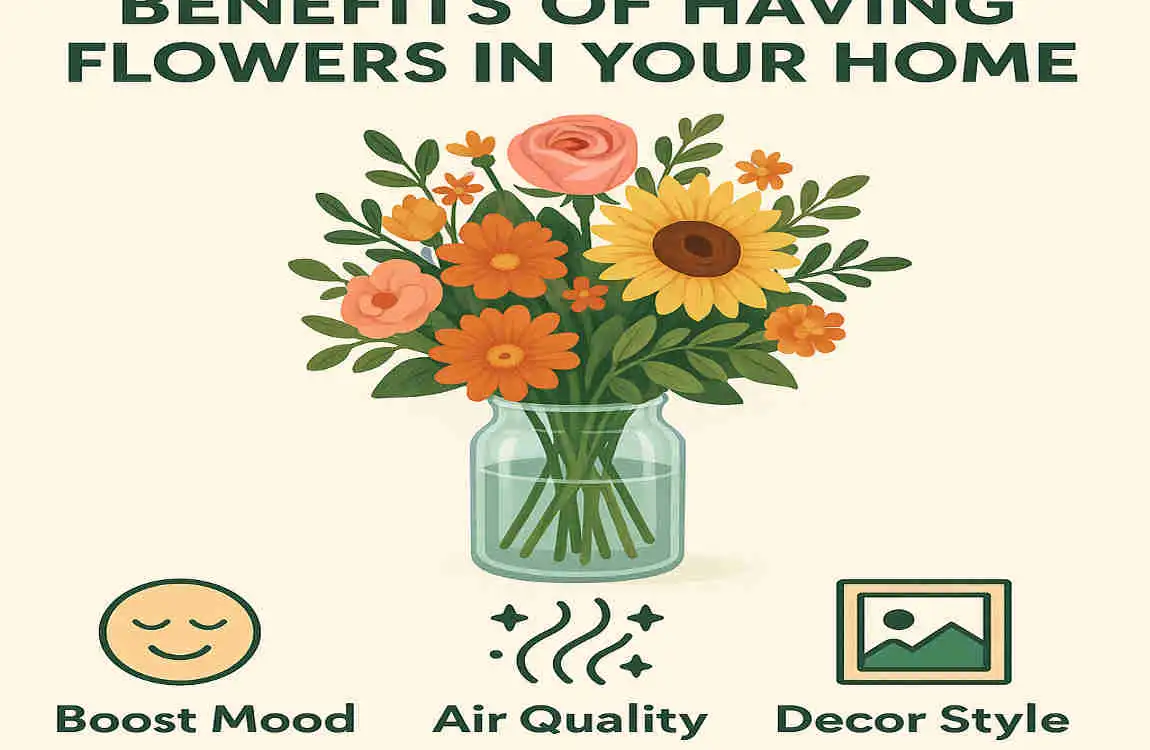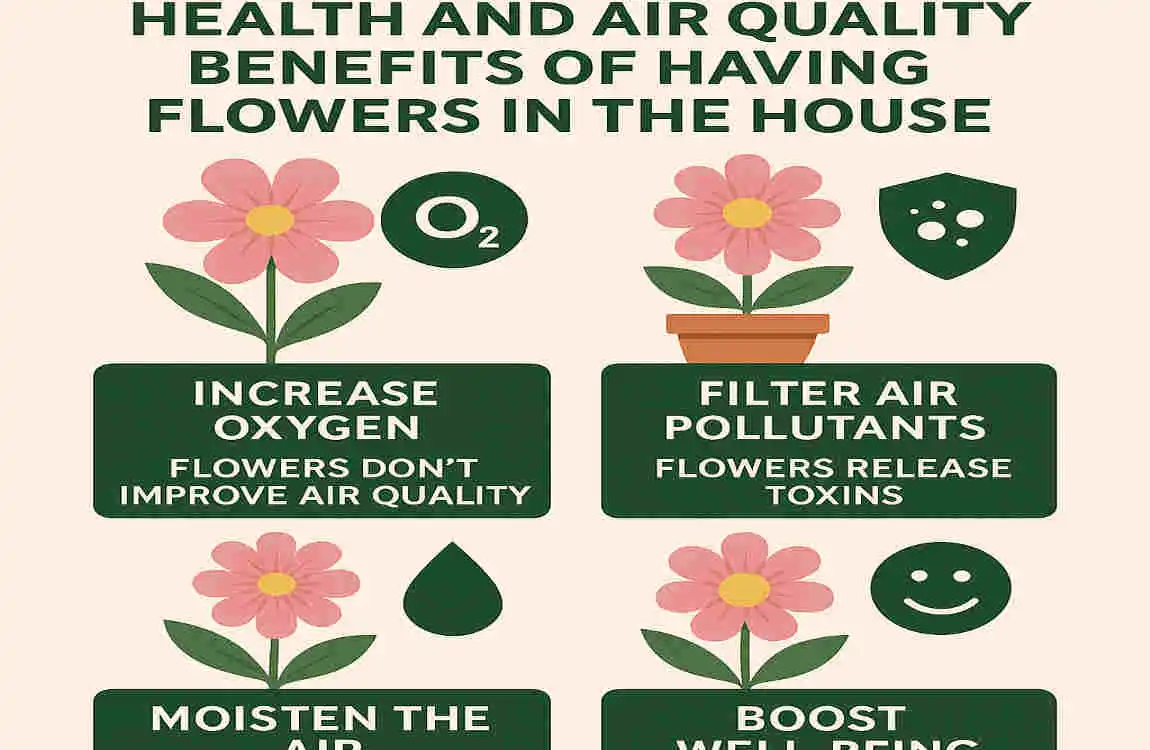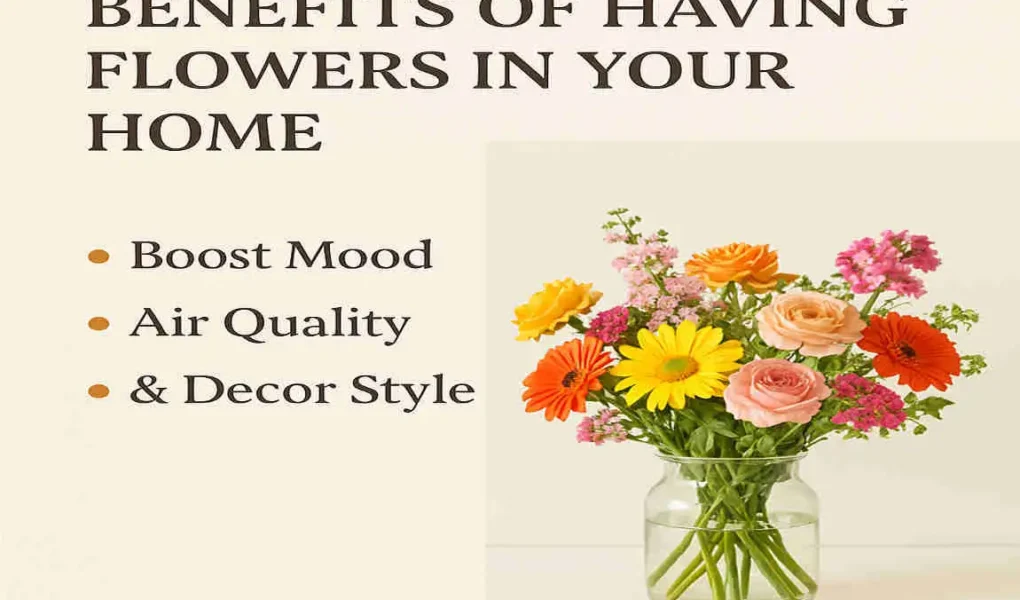Have you ever walked into a room filled with the vibrant colors and delightful scents of fresh flowers? There’s something truly magical about the way flowers can transform a space. But did you know that the benefits of having flowers in your home go far beyond just aesthetics? From boosting your mood to improving air quality and enhancing your home decor, flowers offer a multitude of benefits that can positively impact your life.
Psychological Benefits of Flowers in Your Home

How Flowers Improve Mood and Reduce Stress
It’s no secret that flowers have a way of lifting our spirits. But did you know that there’s actual science behind this phenomenon? Studies have shown that the presence of flowers in a room can increase happiness and reduce stress levels. The vibrant colors and natural beauty of flowers engage our senses and trigger the release of feel-good hormones like serotonin and dopamine.
But it’s not just the visual appeal of flowers that can improve our mood. The simple act of caring for flowers, whether it’s watering them or arranging them in a vase, can be a soothing and meditative experience. Many people find that tending to their indoor garden helps them feel more grounded and connected to nature, even when they’re cooped up inside.
As Dr. Jane Smith, a renowned psychologist and author of “The Healing Power of Flowers,” explains, “Flowers have a unique ability to bring us joy and comfort. They remind us of the beauty and resilience of nature, and that can be incredibly uplifting, especially during times of stress or uncertainty.”
Flowers and Increased Productivity & Creativity
If you’re looking for a natural way to boost your productivity and creativity, look no further than your local florist. Research has shown that having flowers in your workspace can improve focus and concentration. The calming presence of flowers can help reduce distractions and create a more conducive environment for getting things done.
But it’s not just about productivity. Flowers can also stimulate our creative thinking and problem-solving abilities. Certain types of flowers, like sunflowers and gerbera daisies, are known for their ability to inspire and energize. By surrounding yourself with these vibrant blooms, your creative juices flow more freely.
So, whether you’re working from home decor or need a little boost to tackle a creative project, consider adding some flowers to your space. You might be surprised at the difference they can make.
Emotional Connection and Mindfulness
In our fast-paced, technology-driven world, it’s easy to feel disconnected from nature and ourselves. But flowers can help us cultivate mindfulness and emotional connection. By taking the time to appreciate the beauty and fragility of a flower, we can learn to be more present and attuned to our own emotions.
Many people find caring for flowers soothing and meditative. The simple act of watering, pruning, and arranging can be a form of self-care and a way to slow down and connect with the present moment. Some even incorporate flowers into their meditation or relaxation routines, using them as a focal point to help quiet the mind and find inner peace.
If you’re looking for a way to bring more mindfulness into your life, consider starting a small indoor garden or simply keeping a vase of fresh flowers on your bedside table. You might be surprised at how much joy and tranquility these simple blooms can bring.
The Health and Air Quality Benefits of Flowers

How Flowers Contribute to Cleaner, Fresher Air
We all know that plants are nature’s air purifiers, but did you know that flowers can also improve indoor air quality? Many flowers, like peace lilies and orchids, can filter toxins and pollutants from the air, leaving your home feeling fresher and more breathable.
But how exactly do flowers work their magic? It all comes down to a process called phytoremediation. Through their leaves and roots, flowers can absorb harmful chemicals like formaldehyde, benzene, and trichloroethylene, which are commonly found in household products and building materials. By removing these toxins from the air, flowers help create a healthier and more comfortable living environment.
If you’re looking for a natural way to improve your home’s decor air quality, consider adding some flowering plants to your decor. Not only will they add a pop of color and beauty, but they’ll also help you breathe easier.
Flowers and Humidity Regulation
In addition to purifying the air, flowers can also help regulate humidity levels in your home. Certain types of flowers, like ferns and begonias, release moisture through a process called transpiration. This can help balance humidity in your living space, creating a more comfortable, healthier environment.
Maintaining proper humidity levels is essential for both your physical and mental well-being. Low humidity can lead to dry skin, irritated eyes, and respiratory issues, while high humidity can promote mold and mildew growth. By keeping a few humidity-loving flowers in your home, you can help keep these levels in check and enjoy the benefits of a more balanced indoor climate.
Promoting Better Sleep with Indoor Flowers
If you struggle with getting a good night’s sleep, consider adding some flowers to your bedroom. Certain types of flowers, like lavender and jasmine, are known for their calming and soothing properties. The gentle scents of these blooms can help relax your mind and body, making it easier to drift off to dreamland.
But it’s not just the scent of flowers that can promote better sleep. The presence of flowers in your bedroom can also help create a more peaceful and tranquil environment. By surrounding yourself with the beauty and serenity of nature, you may be able to let go of the stresses of the day and slip into a more restful state.
If you’re looking for a natural way to improve your sleep quality, consider adding sleep-friendly flowers to your bedroom decor. You might be surprised at how much of a difference these simple blooms can make.
Enhancing Home Decor Style with Flowers

Flowers as Natural Home Accents
Flowers are the ultimate natural accent for any home decor style. Whether you prefer a modern, minimalist look or a more traditional, cozy feel, there’s a flower arrangement that can complement your aesthetic. From sleek, monochromatic bouquets to lush, colorful displays, the possibilities are endless.
One of the great things about using flowers as decor is their versatility. You can display them in a variety of ways, from classic vases to more unique containers like mason jars or teacups. Hanging gardens and wall-mounted planters are also becoming increasingly popular, allowing you to add a touch of greenery to even the smallest of spaces.
And don’t forget about seasonal flower decor! From the bright, cheerful blooms of spring to the warm, rich colors of fall, there’s always a flower that can help you celebrate the changing seasons and add a touch of timely charm to your home.
Creating Focal Points and Atmosphere
Flowers have a way of drawing the eye and creating a sense of atmosphere in a room. By strategically placing a bouquet or arrangement, you can make a natural focal point that adds character and interest to your space. Whether it’s a dramatic centerpiece on your dining table or a simple vase on your bedside table, flowers can help define and enhance the mood of any room.
But flowers don’t have to stand alone. By combining them with other decor elements, like fabrics, colors, and furniture, you can create a cohesive and inviting atmosphere. For example, a bouquet of soft pink roses can be paired with plush velvet pillows and a cozy throw blanket to create a romantic and inviting bedroom. Or, a vibrant arrangement of sunflowers can be complemented by bright, cheerful artwork and a playful accent chair, adding a pop of energy to your living room.
Flowers and Sustainable Home Design
In addition to their aesthetic benefits, flowers can help create a more sustainable home. By choosing fresh, locally-grown flowers over synthetic or imported decor, you can reduce your carbon footprint and support your local economy. Many florists now offer eco-friendly options, like biodegradable vases and packaging, making it easier than ever to make sustainable choices.
And don’t forget about the benefits of using seasonal blooms! By selecting flowers that are in season and readily available in your area, you can further reduce your environmental impact and enjoy the freshest, most vibrant blooms possible. Plus, seasonal flowers often cost less than their out-of-season counterparts, making them a budget-friendly choice for eco-conscious homeowners.
Practical Tips for Incorporating Flowers at Home

Choosing the Right Flowers for Your Space
When incorporating flowers into your home, it’s essential to choose the right blooms for your space. Factors like lighting, maintenance requirements, and personal taste can all play a role in selecting the perfect flowers for your needs.
If you’re new to indoor gardening, start with some beginner-friendly options. Hardy flowers like chrysanthemums, gerbera daisies, and alstroemeria are all great choices for novice gardeners, as they’re relatively easy to care for and can thrive in a variety of conditions.
When selecting flowers for your home decor, be sure to consider the amount of natural light your space receives. Some flowers, like orchids and African violets, prefer bright, indirect light, while others, like ferns and begonias, can tolerate lower light levels. By choosing flowers well-suited to your home’s lighting conditions, you’ll set yourself up for success.
Caring for Indoor Flowers to Maximize Benefits
Once you’ve selected the perfect flowers for your space, it’s essential to give them the care and attention they need to thrive. Proper watering, sunlight, and temperature are all key factors in keeping your indoor blooms healthy and vibrant.
Most indoor flowers prefer watering when the top inch or two of soil feels dry to the touch. Be sure to use room-temperature water and avoid getting the leaves wet, as this can lead to fungal growth. And don’t forget to empty any excess water from the saucer beneath your pot to prevent root rot.
Sunlight is another crucial factor in flower care. Most indoor flowers prefer bright, indirect light, but the specific needs can vary depending on the type of bloom. Be sure to research the lighting requirements for your chosen flowers, and place them in a spot that meets those requirements.
Temperature is also key. Most indoor flowers prefer temperatures between 65 and 75 degrees Fahrenheit during the day, with a slight drop at night. Avoid placing your flowers near drafty windows or heat sources, as this can cause stress and damage.
By following these simple care tips, you can help your indoor flowers thrive and enjoy their many benefits for longer.
DIY Flower Arrangements and Displays
One of the fun things about incorporating flowers into your home is the opportunity to get creative with DIY arrangements and displays. With a few simple tips and tricks, you can create stunning floral displays that showcase your personal style and add a touch of beauty to your space.
When creating a flower arrangement, start by selecting a variety of blooms in different sizes, shapes, and colors. This will add visual interest and depth to your display. Be sure to remove any leaves or foliage that will fall below the waterline, as this can cause bacterial growth and shorten the life of your arrangement.
Next, choose a vase or container that complements your flowers and fits the style of your space. A tall, narrow vase is perfect for long-stemmed blooms like roses or lilies, while a short, wide container is ideal for fuller arrangements with lots of greenery.
When arranging your flowers, please start with the largest blooms and place them in the center of the vase. Then, add smaller flowers and greenery around the edges, working your way outwards until you achieve the desired shape and fullness. Don’t be afraid to experiment and play with different arrangements until you find one that feels just right.
And don’t forget about the many creative ways you can display flowers throughout your home! From a simple vase on your kitchen table to a lush arrangement on your bathroom vanity, there are endless opportunities to incorporate flowers into your decor and enjoy their beauty and benefits.
Addressing Common Concerns and Myths

Allergies and Flowers: What You Should Know
One common concern people have about bringing flowers into their home is the potential for allergies. While it’s true that some flowers can trigger allergic reactions, there are many hypoallergenic options available that can help you enjoy the benefits of flowers without the sneezing and itching.
When selecting flowers for your home decor, look for varieties known to be low-allergen, such as roses, tulips, and lilies. Avoid flowers with heavy pollen, such as sunflowers and daisies, as they may be more likely to trigger allergies.
If you’re still concerned about allergies, consider using silk or dried flowers instead of fresh blooms. These can provide many of the same aesthetic benefits without the risk of allergic reactions.
And don’t forget about proper flower care! By keeping your flowers well-watered and free of debris, you can help minimize the risk of mold and mildew growth, which can exacerbate allergies.
Flowers vs. Plants: Understanding the Differences
Another common misconception is that flowers and plants are the same thing. While it’s true that flowers are a type of plant, there are key differences between the two worth understanding.
Flowers are the reproductive organs of plants, responsible for producing seeds and attracting pollinators. They often have vibrant colors and enticing scents that help them stand out and attract the attention of bees, butterflies, and other pollinators.
Plants, on the other hand, encompass a wider range of greenery, including trees, shrubs, and foliage plants. While some plants do produce flowers, many do not; instead, they focus on other forms of growth and reproduction.
So, what are the unique benefits of flowers? For one, their vibrant colors and enticing scents can have a powerful impact on our mood and well-being. Flowers also have a relatively short lifespan, which can encourage us to slow down and appreciate their beauty while it lasts.
By understanding the differences between flowers and plants, you can make more informed choices about the types of greenery you bring into your home and the specific benefits you seek.
FAQ: What Are the Benefits of Having Flowers in the House?
How do flowers improve mood and reduce stress?
Flowers have a remarkable ability to uplift your mood and reduce stress. Studies show that the vibrant colors and natural beauty of flowers trigger the release of feel-good hormones like serotonin and dopamine. The simple act of caring for flowers can also be a soothing and meditative experience, helping you feel more grounded and connected to nature.
Can flowers increase productivity and creativity?
Absolutely! Research has linked the presence of flowers and plants to improved focus and concentration. Certain types of flowers, like sunflowers and gerbera daisies, are known for their ability to stimulate creativity. By surrounding yourself with these vibrant blooms, you may find that your productivity and creative thinking get a natural boost.
How can flowers foster emotional connection and mindfulness?
Flowers can help you cultivate a sense of mindfulness and emotional connection. By taking the time to appreciate their beauty and fragility, you can learn to be more present and attuned to your own emotions. Many people find that caring for flowers is a soothing and meditative practice, helping them slow down and connect with the present moment.
How do flowers contribute to cleaner, fresher air?
Flowers, like many plants, have natural air-purifying qualities. They can filter toxins and pollutants from the air through a process called phytoremediation. Flowers like peace lilies and orchids are particularly effective at removing harmful chemicals like formaldehyde, benzene, and trichloroethylene, leaving your home feeling fresher and more breathable.
Can flowers help regulate indoor humidity?
Yes, certain types of flowers can help maintain a balanced indoor humidity level. Flowers like ferns and begonias release moisture through transpiration, which can help counteract the effects of dry air. Maintaining proper humidity is important for your skin, respiratory health, and overall comfort.
Do flowers promote better sleep?
Some flowers, like lavender and jasmine, are known for their calming and soothing properties. The gentle scents of these blooms can help relax your mind and body, making it easier to fall asleep and stay asleep. By creating a peaceful and tranquil environment with flowers, you can improve your sleep quality naturally.
How can flowers enhance home decor style?
Flowers are the ultimate natural accent for any home decor style. Whether you prefer a modern, minimalist look or a more traditional, cozy feel, there’s a flower arrangement that can complement your aesthetic. From sleek, monochromatic bouquets to lush, colorful displays, flowers add beauty, charm, and a touch of nature to your space.
What are some unique ways to display flowers in the home?
There are endless creative ways to showcase flowers in your home. Classic vases are always a beautiful choice, but you can also get creative with mason jars, teacups, or other unique containers. Hanging gardens and wall-mounted planters are also becoming popular, allowing you to add a touch of greenery to even the smallest of spaces.
How can flowers contribute to sustainable home design?
Flowers can play a role in creating a more sustainable home. By choosing fresh, locally-grown flowers over synthetic or imported decor, you can reduce your carbon footprint and support your local economy. Opting for seasonal blooms and eco-friendly vases and packaging further enhances the sustainability of your floral decor choices.




